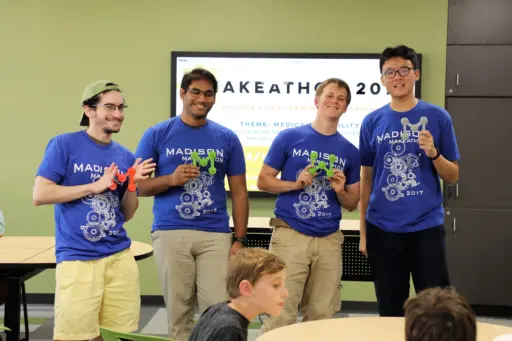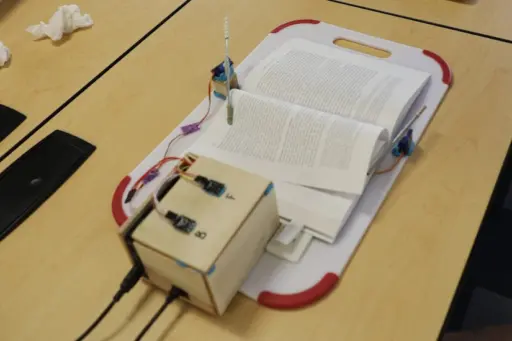Inventors and tinkerers, designers and builders, engineering students from across the UW-Madison campus: Rejoice and behold the splendor of the newly opened Grainger Engineering Design Innovation Laboratory, a makerspace where creativity knows no bounds.
 Second-place winners Vinay Janardhanam, Ted Martinez, Spencer Fricke and Yan Xiao used a Google Tango augmented-reality device to create a system that helps visually impaired users find their way around a building. Submitted photo.
Second-place winners Vinay Janardhanam, Ted Martinez, Spencer Fricke and Yan Xiao used a Google Tango augmented-reality device to create a system that helps visually impaired users find their way around a building. Submitted photo.
The brand-new makerspace, located on the ground (2nd) floor of the Wendt building, is open to all College of Engineering students, faculty and staff, as well as their collaborators from other parts of campus. The 12,000-square-foot space is a maker’s dream; it houses 3D printers, laser cutters, machine tools, virtual and augmented reality hardware, microscopes, soldering irons, bicycle tools and many more instruments and gadgets to assist engineering students in bringing their ideas to life.
To mark the makerspace’s opening in September 2017, the College of Engineering hosted a “Week of Making.” This included hands-on workshops throughout the week and a weekend-long “Makeathon” contest, featuring Matt Kressy, director and founder of MIT’s integrated design and management program and an expert in product design and development. Teams of engineering students competed in the Makeathon to design and build devices that could help solve a medical disability-related challenge.
Students David Lahm, Alec Hill and Yuchen Gu won first place with their prototype for a haptic stethoscope. The stethoscope is designed for to be useful for all doctors, including those with hearing loss; traditional stethoscopes do not operate well with hearing aids or cochlear implants. The three-person team used makerspace equipment to design and build a stethoscope that features a sensitive microphone located behind a diaphragm that detects the sound vibrations of a beating heart, and then filters, amplifies and projects it through an actuator, recreating the vibration mechanically.
 A prototype of an electronic page turner, which can be clipped to a book and turn pages for readers. Submitted photo.
A prototype of an electronic page turner, which can be clipped to a book and turn pages for readers. Submitted photo.
Second-place winners Vinay Janardhanam, Ted Martinez, Spencer Fricke and Yan Xiao used a Google Tango augmented-reality device to create a system that helps visually impaired users find their way around a building. Third-place winners Seth Eiseman, Kevin Kirk and Ben Gabbard built a prototype of an electronic page turner, which can be clipped to a book and turn pages for readers.
In addition to providing a venue for a fun, engineering-oriented competition, the Makeathon showcased the breadth of opportunities awaiting students—even those with no experience using the specialized design and fabrication equipment housed in the makerspace. The Makeathon will be an annual competition, according to Gopika SenthilKumar and Max Goldberg, who are both undergraduate engineering students involved in the Makerspace and helped organize the event.
And while the Makeathon helped showcase the new Makerspace, the facility’s core purpose is to be a resource for engineering students as they work on class projects or develop their own ideas. The possibilities really are as limitless as the ideas that users bring to the space.
For more information about the UW Makerspace, including hours and fees, visit making.engr.wisc.edu.